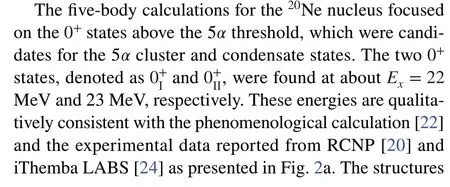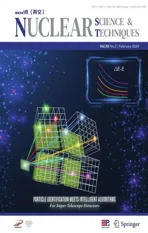The 5α condensate state in 20Ne
2024-04-25TakahiroKawabata
Takahiro Kawabata
Theαclustering phenomenon, in which nucleons are arranged intoαparticles (4He nuclei) within a nuclear system, is one of the most intriguing aspects of nuclear structure.It has been observed in various light nuclei, such as8Be,12C,16O, and20Ne, and is responsible for many exotic and fascinating phenomena, such as the Hoyle state in12C,which plays an essential role in stellar nucleosynthesis [1—6]as well as in heavy-ion collisions [7—9].
A particularly interesting question is whether theαclusters can form a Bose—Einstein condensate (BEC) state, in which theαparticles occupy the same quantum state and behave as a coherent matter wave.Such a state has been observed in dilute atomic gases [10] and has been speculated to exist in nuclear systems [11, 12].The BEC influences physical properties of nuclear matter.If the BEC is indeed an inherent nature of nucleon many-body systems, nuclear matter reduces its energy at low density by organizingαclusters and condensing them into the lowest-energy state.This softening of dilute nuclear matter is mitigated in asymmetric nuclear matter due to a decrease in the population ofαclusters with increasing asymmetry.Thus, the BEC could increase the symmetry energy of nuclear matter and exert a significant impact on the equation of state (EOS) for nuclear matter.Construction of the EOS for nuclear matter is one of the ultimate goals in nuclear physics.It serves not only as a benchmark for our comprehension of strongly interacting fermions but also as a foundation for understanding astrophysical phenomena such as supernovae and neutron stars.
However, it remains unclear whether the BEC manifests in dilute nuclear matter.Establishing the BEC states in various nuclei is desired because the ubiquity of the BEC states in finite nuclei could be strong evidence that the BEC is an inherent nature of nuclear systems.Despite this significance,the presence of the BEC states has only been reported in a limited number of light nuclei.
In8Be, the ground state is regarded as a 2αBEC state.The 0+2state in12C, known as the Hoyle state with a gas-like 3αstructure, is also considered to be a manifestation of the 3αBEC [13—15].Similarly, the 0+6state in16O, which has a dominant 4αstructure, is a strong candidate for the 4αBEC state [16—18], but the experimental confirmation is challenging.If the 0+6state is really the 4αBEC state, its wave function has a large overlap with that of the Hoyle state as the 3αBEC state.However, the large overlap does not result in the large decay width of the 0+6state to the Hoyle state due to the small decay energy which makes it difficult forαclusters to penetrate the Coulomb barrier [19].
Recently, we reported candidates of the 5αBEC states in20Ne by measuringαparticles inelastically scattered from20Ne in coincidence with decay charged particles [20].We found new states atEx=21.2 , 21.8, and 23.6 MeV in20Ne,which dominantly decay to the 0+6state in16O as the strong candidate for the 4αBEC state.Furthermore, we reported the candidates for the 6αBEC state and its excited states in24Mg from a measurement of the12C+12C scattering [21].However, unfortunately, no fully microscopic calculation on the BEC states was available in20Ne and heavier nuclei at that time except for a phenomenological calculation assuming theαclusters as point-like bosons [22], although detailed comparison between experimental and theoretical results are essential to pin down the BEC states in atomic nuclei.
In a very recent work, Zhou et al.[3] extended their theoretical study of theαcondensation phenomenon to the20Ne nucleus, which has a rich clustering structure and a 5αthreshold atEx=19.2 MeV, using the Tohsaki—Horiuchi—Schuck-Röpke (THSR) wave function [23] for the first time.The THSR wave function is particularly suitable for describing the gas-like states and the authors found two 0+states above the 5αthreshold, one of which has a clear 5αcondensate character.Figure 1 illustrates their result that one of the predicted states is considered to be the 5αBEC state with a dilute gas-like nature where the 5αclusters occupy the lowest-energy 0Sorbit, whereas the ground state has a compact shell-model-like structure, where 20 nucleons occupy single-particle orbits in a mean-field potential and behaves like quantum liquid at normal densityρ0.The structure and decay properties of this state show that it has a remarkable link with the 4αcondensate state in16O.The results suggest that theαcondensation phenomenon can occur in heavier nuclei under similar conditions as in12C and16O.and decay properties of these states were analyzed using various observables.

Fig.1 (Color online) Diagrammatic representation for the shellmodel-like ground state and the possible 5 α condensate state in 20Ne.See Ref.[3] for more details


Theαdecay from the 5αcondensate state into the 4αcondensate state is another important aspect of the 5αcondensate state.The calculated partialαdecay width of the predicted 5αcondensate state is as high as 0.7 MeV.Thus,this dominated decay channel can be measured directly in the experiment.The decay widths to the 0+2state and the ground state of16O are also comparable and large enough.This information may help experiments to determine thestate (Ex≈22 MeV ) predicted in this work and offer a great opportunity for further exploration of the BEC in the nuclear system.

Fig.2 (Color online) a) Comparison of theoretical predictions with the experimental results for the 5α cluster states above the threshold[20, 24] and the phenomenological calculation [22].b The calculated reduced width amplitudes of the state and 0+II state in 20 Ne in the channel of 16O(0+6)+α.See Ref.[3] for more details
Open AccessThis article is licensed under a Creative Commons Attribution 4.0 International License, which permits use, sharing, adaptation, distribution and reproduction in any medium or format, as long as you give appropriate credit to the original author(s) and the source,provide a link to the Creative Commons licence, and indicate if changes were made.The images or other third party material in this article are included in the article’s Creative Commons licence, unless indicated otherwise in a credit line to the material.If material is not included in the article’s Creative Commons licence and your intended use is not permitted by statutory regulation or exceeds the permitted use, you will need to obtain permission directly from the copyright holder.To view a copy of this licence, visit http://creativecommons.org/licenses/by/4.0/.
杂志排行
Nuclear Science and Techniques的其它文章
- Measurement of the neutron-induced total cross sections of natPb from 0.3 eV to 20 MeV on the Back-n at CSNS
- Nuclear charge radius predictions by kernel ridge regression with odd-even effects
- Unbound 28 O, the heaviest oxygen isotope observed: a cutting-edge probe for testing nuclear models
- Development of CONTHAC-3D and hydrogen distribution analysis of HPR1000
- Total ionizing dose effect modeling method for CMOS digital-integrated circuit
- A fast forward computational method for nuclear measurement using volumetric detection constraints
